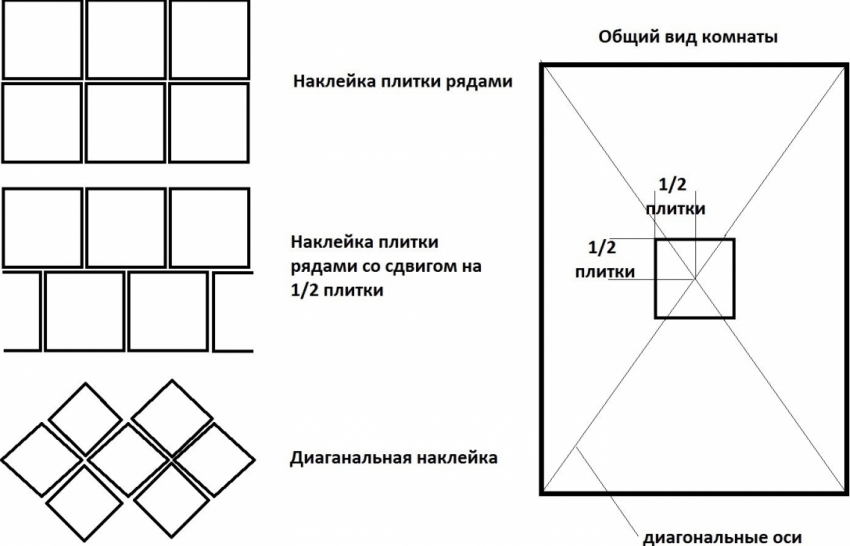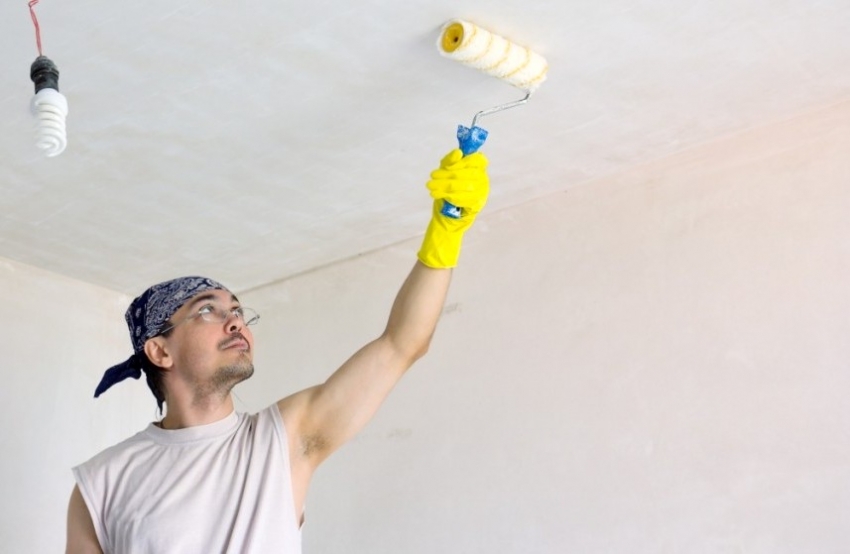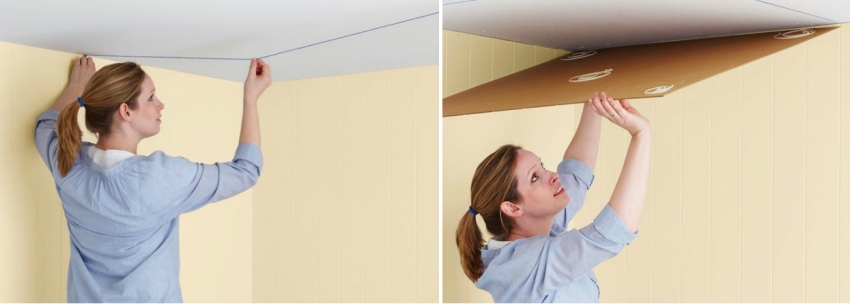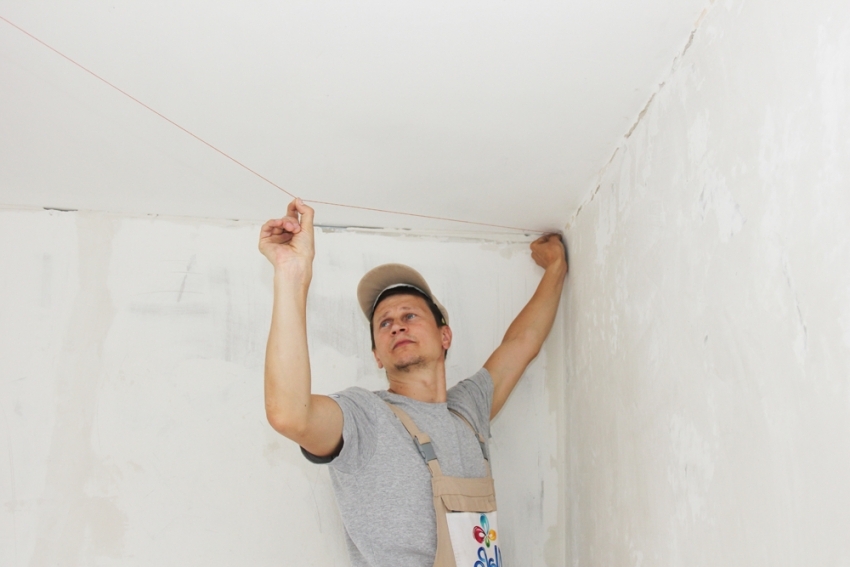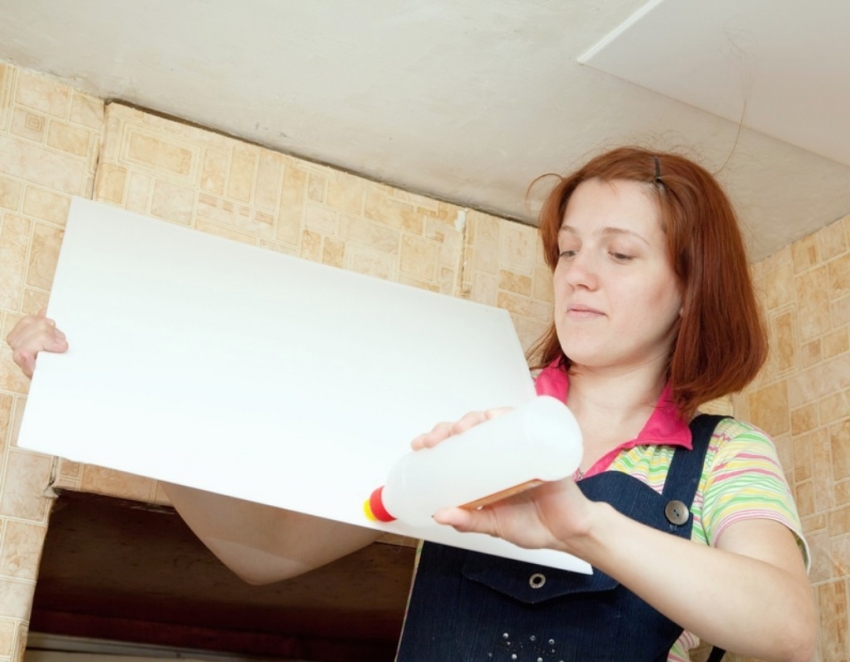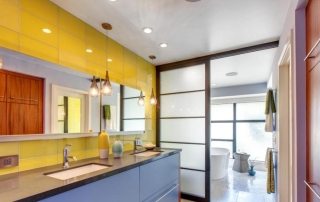The beautifully designed ceiling is sure to catch any eye. The general perception of the room as a whole depends on its appearance. Ceiling tile is one of the most popular materials for interior decoration, which can transform any room, making it unique and interesting. The types of material, the rules for its selection and how to properly glue the ceiling tiles are detailed in this article.
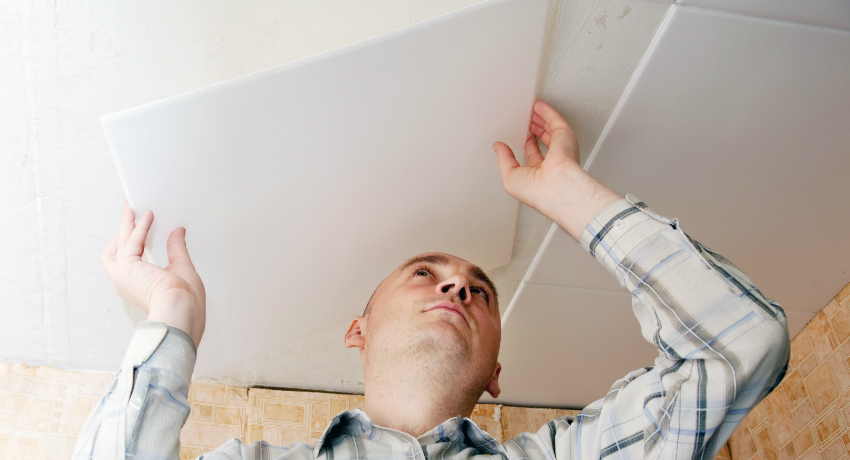
With the help of ceiling tiles, you can decorate the ceiling beautifully without a lot of time and money.
Content [Hide]
- 1 Varieties of expanded polystyrene ceiling tiles
- 2 Determination of the amount of material depending on the area of the ceiling
- 3 How to glue tiles to the ceiling: options for placing products
- 4 How to properly glue ceiling tiles?
- 5 What to glue the ceiling tiles on?
- 6 Ceiling Tile Care
- 7 How to glue ceiling tiles with your own hands. Video instruction
Varieties of expanded polystyrene ceiling tiles
Today manufacturers produce several options for ceiling tiles. Manufacturing technology distinguishes:
- extruded;
- injection;
- stamped.
The surface of the ceiling tiles can be laminated, seamless or mirrored. Laminated products are covered with a special film, which gives the tiles increased moisture resistance. It is available in a wide range of colors and does not lose its rich color for a long time. On the front side mirror tiles a special layer has been applied, thanks to which you can achieve a visual expansion of the space.
Seamless ceiling tiles have smooth edges, thanks to which the joints are invisible. On the back of the products, there are markings in the form of triangular arrows. They should point in the same direction. This must be taken into account before gluing the ceiling tiles.
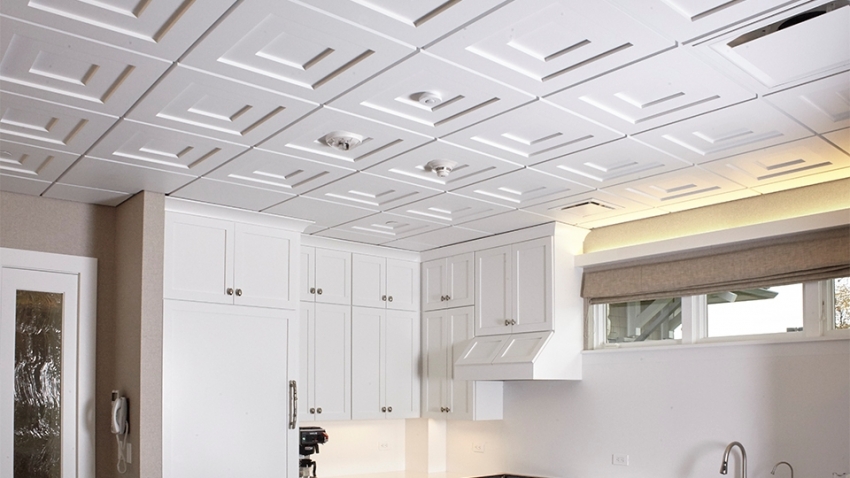
Injection tile is an environmentally friendly and durable material that has high sound and heat insulation characteristics.
Extruded tiles are produced from a painted or film-coated polystyrene strip produced by pressing. The result is a smooth or embossed product without grain, 2.5-3 mm thick. This is the most reliable, durable and expensive tile. Thanks to the water- and dust-repellent coating, the product is well washed and easily restored at the slightest deformation. With a dense structure, the tile is easy to cut, which creates smooth edges.
Very often, tiles are produced with a surface painted like wood, stone or marble.It can contain different patterns and be of different colors. The material is ideal for bathrooms.
Important! The extruded type of tile cannot be painted.
A distinctive feature of extruded tiles is their appearance. Its edges are slightly curved downwards on the back side, which allows it to be used for uneven ceilings, where it will be possible to hide its imperfections. However, with prolonged exposure to sunlight, the tile turns yellow. The price of ceiling tiles is on average 220-270 rubles. per packing.
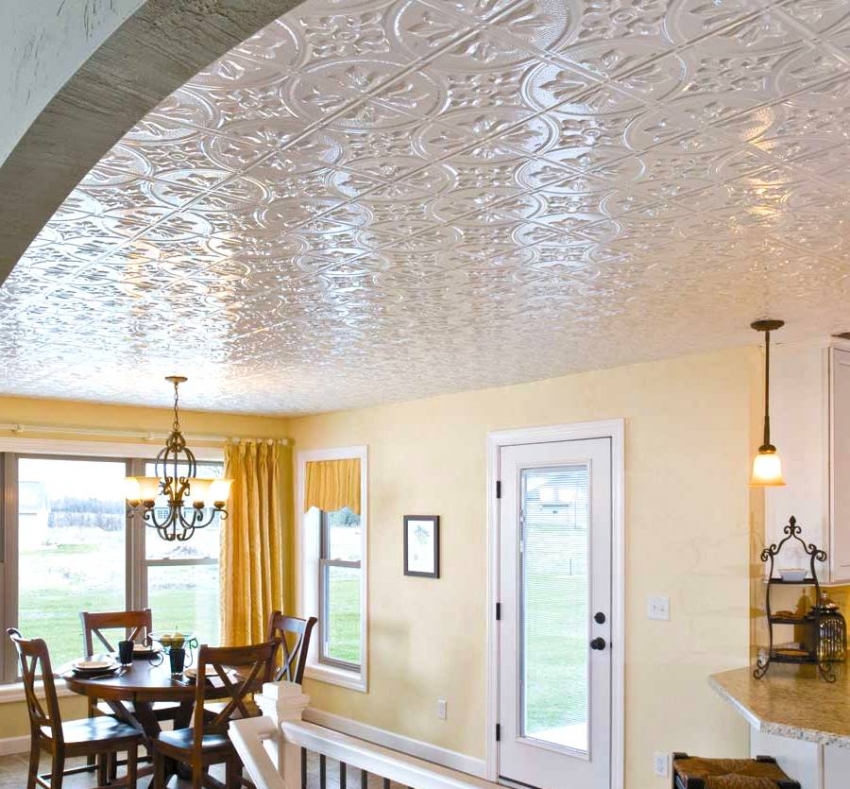
Stamped tiles in the form of expanded polystyrene blocks can be painted in different colors using a special dye
Budget ceiling tile options
Injection tile is obtained as a result of sintering raw materials of expanded polystyrene composition. After such processing at a high temperature, a product with a clearly defined pattern and regular geometric shape is obtained, the thickness of which is 9-14 mm. Using this material, you can make a ceiling without seams. This type of ceiling tile is an environmentally friendly, durable, non-combustible material that has good sound and heat insulation characteristics, and is not afraid of moisture.
It is available in white only. The finished surface can be painted. The price of a package is on average 80-150 rubles.
When the main question is how much a ceiling tile costs, the most budgetary option is a pressed product 6-8 mm thick, the price of which does not exceed 60 rubles. per packing. The tile is made from expanded polystyrene blocks by stamping. The material has a loose, porous surface that quickly absorbs dirt that is difficult to remove. It is strongly discouraged to wash such tiles. It is better to paint it immediately with water-based paint. Due to the fact that the product is too fragile and fragile and it is difficult to achieve an even edge during cutting, it is recommended to purchase tiles with a certain margin.
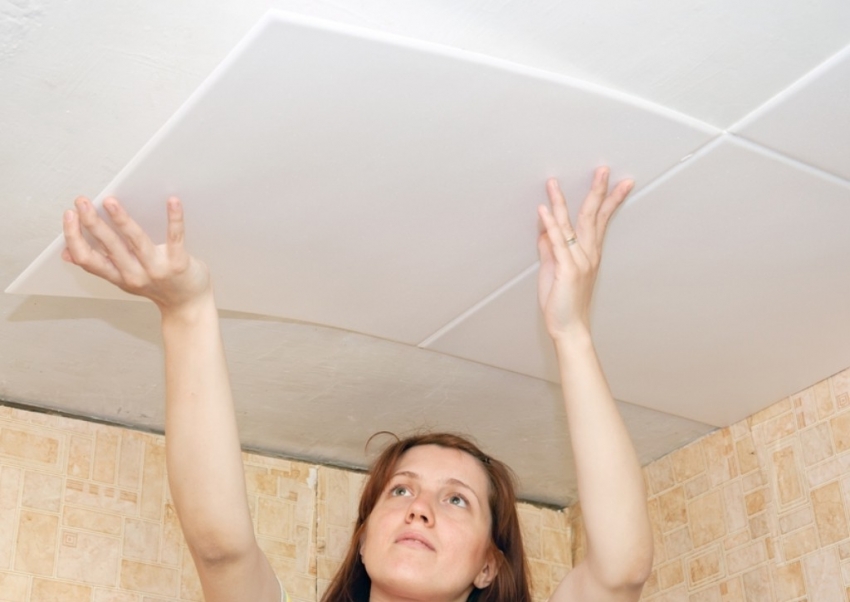
Injection tiles of small thickness have a rather fragile structure, so special care should be taken during installation.
Advantages and Disadvantages of Ceiling Tiles
Styrofoam ceiling tiles are suitable for almost all surfaces, including plaster, wood, brick, concrete and even plaster. With the help of this material, you can create a beautiful and aesthetic ceiling lining that can hide all surface imperfections. Depending on the type of product chosen and the option for gluing the tiles to the ceiling, you can visually increase the size of the room, reduce the curvature of the walls.
The material has high heat and sound insulation properties, which is especially important for apartments in multi-storey buildings. Ceiling tile gluing is not a laborious process and does not require any special skills. In case of deformation of one or more products, they can be easily replaced with new ones without repairing the entire ceiling.
Ceiling tiles are easy to maintain without the use of special products. The surface is cleaned with a dry cloth or vacuum cleaner. For laminated flooring, you can wet clean using conventional detergents, which will not lead to deformation of the products.
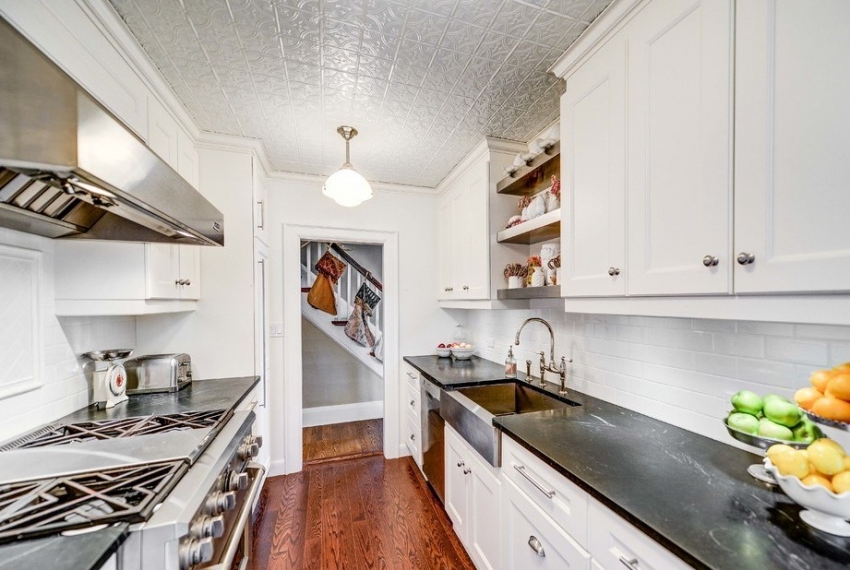
Injection tiles are not afraid of the effects of steam and moisture, so they can be used for finishing the ceiling in the bathroom and kitchen
From the disadvantages of ceiling tiles, one can single out the fact that the material burns out over time under the influence of direct sunlight. Certain types of products can lose their shape when exposed to moisture. Also, when using this facing material, do not place lighting devices close to it, which can lead to deformation of the product.
Determination of the amount of material depending on the area of the ceiling
In order to find out the required number of tiles, you should calculate the ceiling area.If the room resembles a rectangle, then it is enough to multiply its width and length, the values of which are previously measured with a tape measure. If the room has a complex non-standard shape, then it is necessary to measure the length of all sides and depict them on the plan. Next, the drawing should be divided into even rectangles or squares. Having determined the area of each section, and adding the obtained values, it will be possible to calculate the total area of the ceiling.
Next, you should calculate the area of one product, which is produced mainly in the standard size of 50 × 50 cm. Thus, the area of one product will be equal to 0.25 m². Now the resulting ceiling area must be divided by the area of one tile and get their total number. However, today, manufacturers have begun to produce other sizes of ceiling tiles, such as 40 × 40, 60 × 60, 40 × 70, 30 × 70 and 30 × 60 cm.
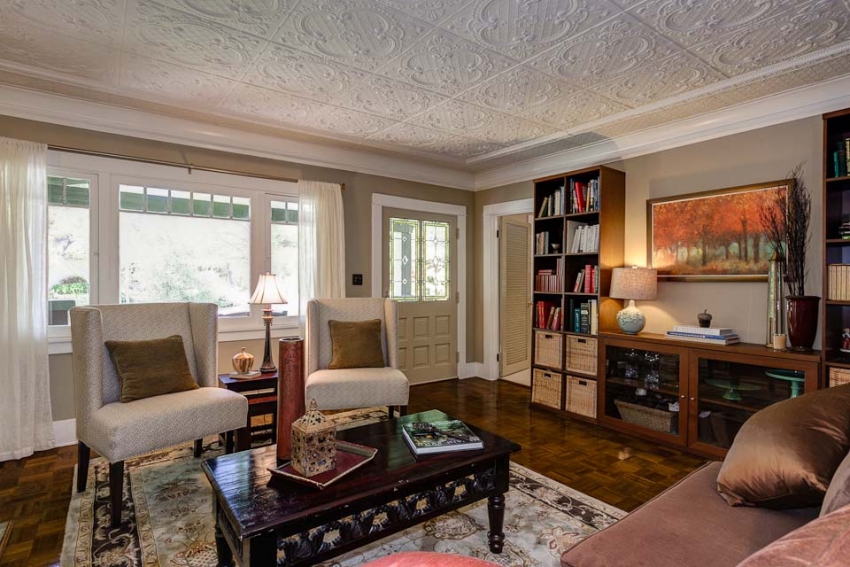
When buying a tile for finishing the ceiling, it is worth buying 1-2 more products for cases of block breakage when gluing or an uneven cut
However, it should be remembered that when gluing products, errors are possible that will lead to deformation, damage or breakage of the tile. It is also worth considering the dimensions of the gaps that form on the ceiling after gluing whole tiles. If half the tiles are needed to fill them, then the whole product will fill two gaps. And if the size of the space takes up more than half, then the whole tile is consumed. Therefore, the material should be purchased with a certain margin of about 10% of the total.
How to glue tiles to the ceiling: options for placing products
There are many options for placing ceiling tiles. Photos of beautifully decorated ceilings using this material clearly demonstrate this. Here you can create different geometric shapes, combine products using tiles of different colors. However, each option requires accurate marking.
Installation of tiles is carried out mainly from the middle of the ceiling. To define it, you need to draw two diagonal lines. Further, for easy installation of the tiles, perpendicular straight lines should be drawn to each side, which pass through the center. Such markings are mandatory and universal, regardless of the tile installation method.
Helpful advice! It is better to install ceiling tiles in a small room from a corner, which will create a continuous surface without increasing material consumption.
The main options for laying the product on the ceiling:
- classical;
- diagonal;
- chess order;
- snake.
The classic laying of tiles is carried out in rows parallel to the walls, starting from the center. It is ideal for seamless ceiling tiles to create a coherent cladding surface. Also, products can be glued in rows with a shift of half of the tile. This will give lightness and airiness to the room.
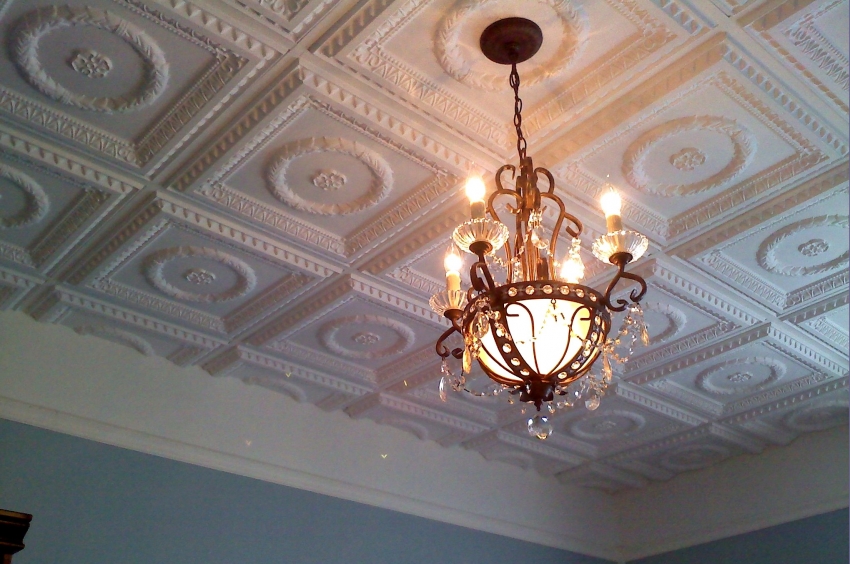
The shape and size of the tiles for decoration should be chosen based on the height of the ceilings in the room
The second option involves gluing products along diagonal lines, with the help of which the correct laying of the tiles will be controlled. The result is a smooth and beautiful ceiling.
For laying tiles in a checkerboard pattern, products of two colors are used, with the help of which the necessary effect of a checkerboard is created by the method of alternation. They begin to lay the tiles from the center of the ceiling, placing the edges of the products parallel to the walls. This option allows you to hide the imperfections of the ceiling surface.
For the latter option, you will need tiles in two contrasting shades. Laying products starts from the center, where a graphic representation of a snake twisted in a spiral is created.
Related article:
Ceiling tiles from foam: their types and installation features
Varieties of expanded polystyrene ceiling tiles, their advantages and disadvantages, installation features and useful tips for pasting.
How to properly glue ceiling tiles?
Before gluing the tiles to the ceiling, you need to prepare the surface for finishing. It must be completely cleaned of old finishes. In the presence of depressions, dents, cracks, significant irregularities, defects should be eliminated with a putty. After the material has completely dried, it is necessary to prime the surface in order to improve the adhesion of the ceiling and future tiles.
Helpful advice! Before gluing the ceiling tile, leave it in a warm and dry place for two to three days so that excess moisture can evaporate from it. Otherwise, the products may shrink on the ceiling, which will cause the formation of cracks.
To complete the work, you will need a clerical knife, a ruler, a pencil, ladder and glue. After the preparatory work, the ceiling is marked with the determination of its center point. All windows and doors in the room should be closed to exclude the possibility of a draft. Further, the direct installation of products is carried out.
Important!Before installing the tiles at the location of the chandelier, you must de-energize the room.
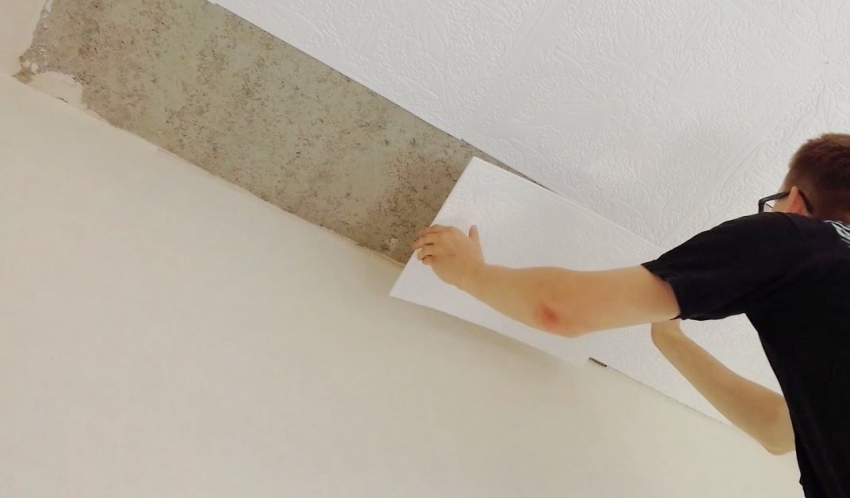
Particular attention should be paid to the installation of tiles near the wall in order to leave a minimum gap and not to glue the canvas with an overlap, which can lead to irregularities that are very visible on the ceiling
Before gluing the tiles to the ceiling, you should apply special glue. Depending on the selected material, it can be distributed around the perimeter of the product and in the center, or in a thin layer over its entire surface. Particular attention should be paid to the middle and corners of the product. The first tile is attached to the middle of the ceiling and pressed tightly against it. If there is a chandelier here, then a hole for the wires must first be made in the product. All subsequent tiles are laid according to the chosen option.
All ceiling tiles should be in close contact with each other without leaving visible gaps. In the case of an uneven ceiling, gaps will inevitably form between products. In this case, they can be sealed with a white acrylic sealant. It is squeezed into the cracks formed, filling them, and thereby strengthening the tiles on the ceiling. Excess glue must be removed immediately.
Helpful advice!If the tile is very soft, press it down with a wooden bar so as not to damage the surface of the product with your fingers.
When it is necessary to trim tiles at the edge of the ceiling, you must first try them. The product should be cut in such a way as to create a minimum gap between the wall and the tile, which will subsequently be hidden behind the skirting board.
After the veneer is completely dry, you can paint it with latex or acrylic based water-based paint. For uniform application of the layer, use a foam roller. Apply at least two coats. It is recommended to prime the surface before painting.
How to glue ceiling tiles diagonally and with a diamond
When laying foam plastic ceiling tiles diagonally, you can get an unusual cladding that will not only add originality to the interior, but will also skillfully hide the slight curvature of the walls.
Before gluing the tiles to the ceiling, a universal surface marking is performed. The first tile is glued in the center so that its corners are located at 45 degrees. relative to the walls of the room and crossed the diagonals of the ceiling.Further, the next tile is glued close to each of the four sides. Then all subsequent products are neatly joined until the ceiling is completely filled.
The outer rows are stacked last, when the main central part of the surface is pasted over.
Before you glue the ceiling tiles with a diamond, you should familiarize yourself with the features of this finishing technology. The first step is to determine the center of the ceiling and mark it up. The first tile should be glued so that one corner touches the center, and two adjacent sides coincide with the diagonal lines. The second tile is located symmetrically on the other side of the center. The third and fourth fit into the spaces between the first two, thereby forming an even rhombus. The rest of the tiles are laid from it, moving to the edges of the ceiling. Here you should carefully join the products to avoid visible seams.
This method is ideal for a ceiling tile made of expanded polystyrene with a pronounced pattern, which gives free rein to the embodiment of design imagination. However, it should be borne in mind that to create a perfect pattern on the ceiling, the consumption of material increases significantly.
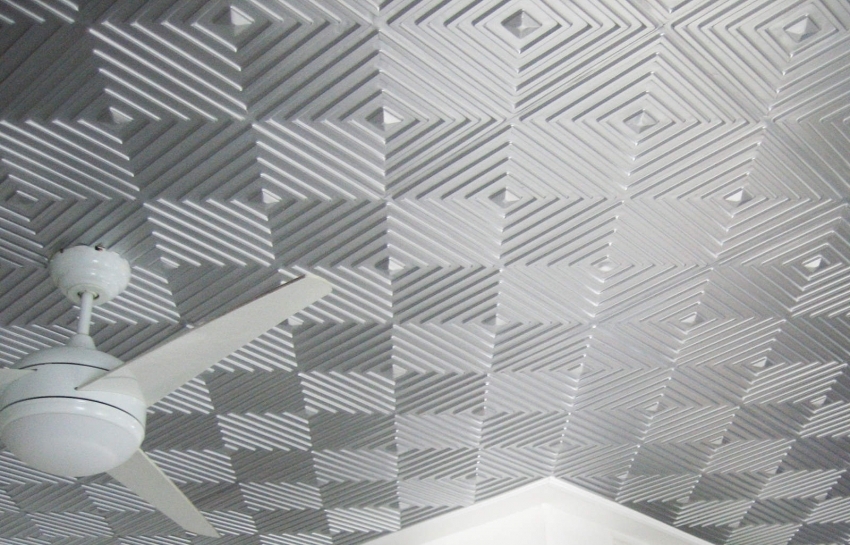
For even finishing the ceiling with tiles in the form of rhombuses or a checkerboard, you should divide the ceiling into parts and mark them additionally
What to glue the ceiling tiles on?
When the important question arises of how to glue the ceiling tiles, it is worth considering all the available compositions, evaluating their distinctive features. Consideration should be given to heat resistance, stickiness, setting and drying times.
The water-based adhesive is durable, reliable and environmentally friendly. It is formulated with natural ingredients such as bone glue and cellulose. However, this is what promotes the growth of bacteria under the product. Therefore, the surface of the ceiling must be treated with a special antibacterial agent before laying tiles using this composition. The disadvantage of the glue is that it dries for a long time and has low adhesion in comparison with synthetic compounds.
Solvent based ceiling tile adhesive is made from highly volatile liquids where different polymers dissolve. It dries quickly, which makes it difficult to install products.
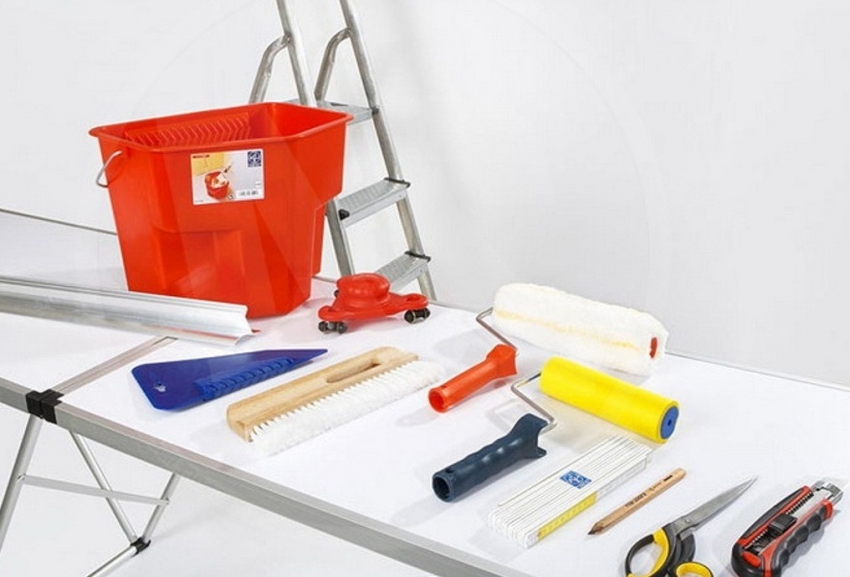
Often, ceiling tile adhesive dries very quickly, so it's best to prepare all the necessary tools in advance.
The hot melt adhesive contains only thermoplastic polymers, which makes it the best material based on polyurethane. It has high adhesion. However, before using it, it must be heated to a certain temperature, which creates difficulties for a beginner who is installing tiles for the first time.
Glue "liquid nails", the instruction of which suggests its use for ceiling tiles made of expanded polystyrene, is the best option for uneven coatings. The composition creates a strong and reliable connection. The disadvantage of the composition is its high price and the need to purchase a special tool.
When the question arises, how to glue the tiles in order to ensure the maximum service life of the facing surface, you should give preference to an adhesive compound. It is made on the basis of epoxy or polyester resins. It is very easy to use and provides maximum adhesion. However, it is worth considering that the glue sets quickly, so it is recommended to cook it in small portions. The main disadvantage of this composition is its high cost.
Ceiling Tile Care
In order for the ceiling to always have an attractive appearance, it is enough not only to decorate it beautifully, but also to maintain the coating in proper condition. Ceiling tiles do not require special maintenance. It is enough just to regularly clean it from the accumulated dust.This will extend the life of the material and preserve the original appearance of the ceiling for a long period.
To keep the tile looking well-groomed, it is necessary to dry clean it once a month with a fluffy brush or vacuum cleaner. Wet cleaning for laminated surfaces should be done at least every two months. Here you can use ordinary detergents that do not contain corrosive ingredients that can damage the surface of the products.
Helpful advice!Light dirt can be easily removed from the tiles with a regular eraser or alcohol.
If traces of sudden flooding by neighbors appear on the ceiling, they should be eliminated immediately. Otherwise, after the tiles dry, rust spots will remain on the surface, which cannot be removed.

Ceiling tiles are quite easy to maintain, but it is worth paying attention to which type of tile is best for which room
Tiles with a pronounced textured pattern should be cleaned with a soft sponge dipped in a cleaning solution. After wet cleaning, wipe the tiles dry using paper towels, as the remaining wet stains will ruin the appearance of the ceiling.
Gluing tiles to the ceiling is a fairly easy task that even a beginner can easily handle. The main task is to thoroughly clean the surface, the correct marking of the ceiling, the choice of high-quality glue and finishing material. Further, having studied the question of how to properly glue the tiles to the ceiling, you can create a unique surface that will harmoniously fit into the overall design of the room.

